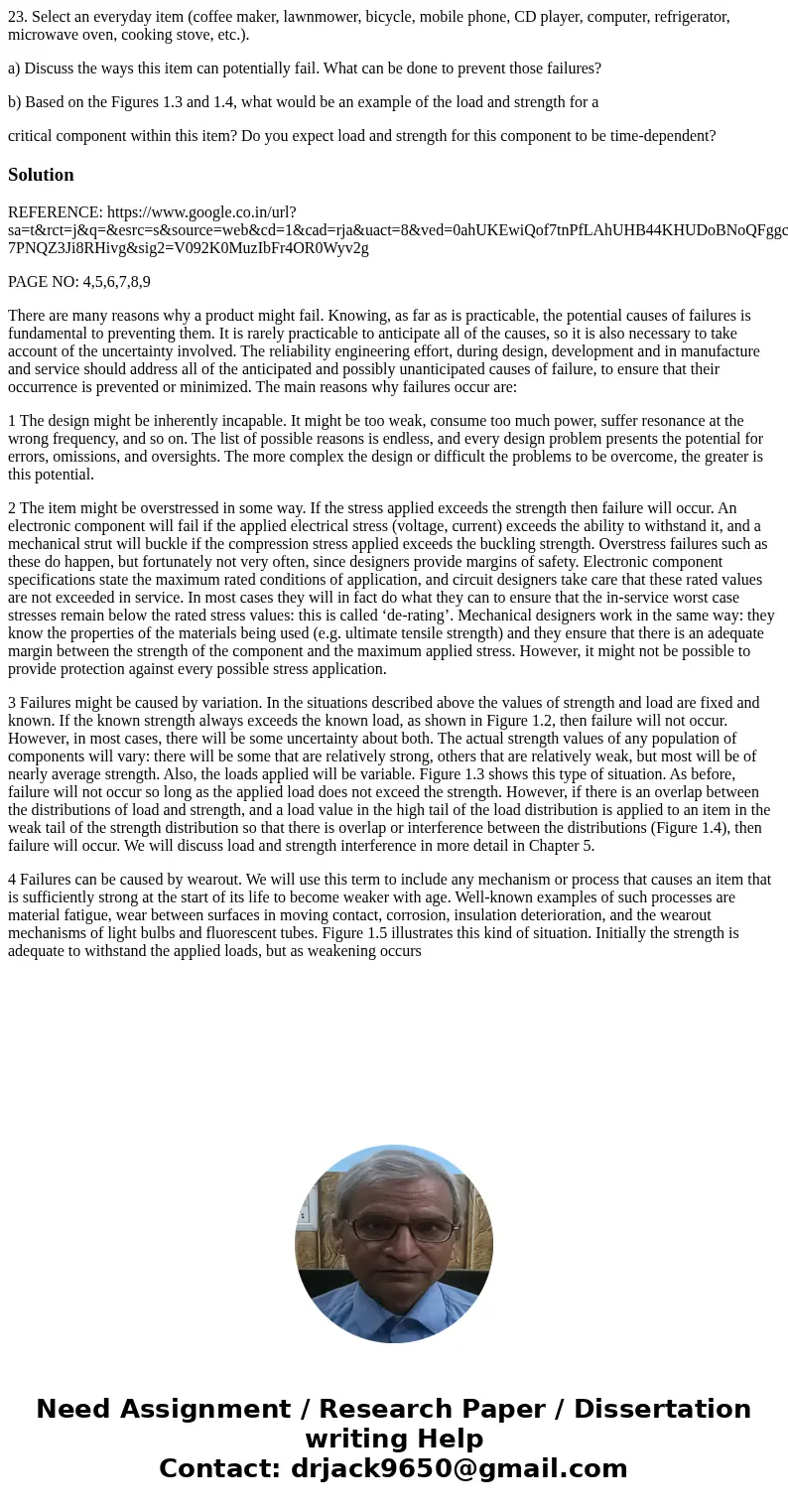23 Select an everyday item coffee maker lawnmower bicycle mo
23. Select an everyday item (coffee maker, lawnmower, bicycle, mobile phone, CD player, computer, refrigerator, microwave oven, cooking stove, etc.).
a) Discuss the ways this item can potentially fail. What can be done to prevent those failures?
b) Based on the Figures 1.3 and 1.4, what would be an example of the load and strength for a
critical component within this item? Do you expect load and strength for this component to be time-dependent?
Solution
REFERENCE: https://www.google.co.in/url?sa=t&rct=j&q=&esrc=s&source=web&cd=1&cad=rja&uact=8&ved=0ahUKEwiQof7tnPfLAhUHB44KHUDoBNoQFggcMAA&url=http%3A%2F%2Fsamples.sainsburysebooks.co.uk%2F9781119961277_sample_414927.pdf&usg=AFQjCNH1yAYJvy5QlKm-7PNQZ3Ji8RHivg&sig2=V092K0MuzIbFr4OR0Wyv2g
PAGE NO: 4,5,6,7,8,9
There are many reasons why a product might fail. Knowing, as far as is practicable, the potential causes of failures is fundamental to preventing them. It is rarely practicable to anticipate all of the causes, so it is also necessary to take account of the uncertainty involved. The reliability engineering effort, during design, development and in manufacture and service should address all of the anticipated and possibly unanticipated causes of failure, to ensure that their occurrence is prevented or minimized. The main reasons why failures occur are:
1 The design might be inherently incapable. It might be too weak, consume too much power, suffer resonance at the wrong frequency, and so on. The list of possible reasons is endless, and every design problem presents the potential for errors, omissions, and oversights. The more complex the design or difficult the problems to be overcome, the greater is this potential.
2 The item might be overstressed in some way. If the stress applied exceeds the strength then failure will occur. An electronic component will fail if the applied electrical stress (voltage, current) exceeds the ability to withstand it, and a mechanical strut will buckle if the compression stress applied exceeds the buckling strength. Overstress failures such as these do happen, but fortunately not very often, since designers provide margins of safety. Electronic component specifications state the maximum rated conditions of application, and circuit designers take care that these rated values are not exceeded in service. In most cases they will in fact do what they can to ensure that the in-service worst case stresses remain below the rated stress values: this is called ‘de-rating’. Mechanical designers work in the same way: they know the properties of the materials being used (e.g. ultimate tensile strength) and they ensure that there is an adequate margin between the strength of the component and the maximum applied stress. However, it might not be possible to provide protection against every possible stress application.
3 Failures might be caused by variation. In the situations described above the values of strength and load are fixed and known. If the known strength always exceeds the known load, as shown in Figure 1.2, then failure will not occur. However, in most cases, there will be some uncertainty about both. The actual strength values of any population of components will vary: there will be some that are relatively strong, others that are relatively weak, but most will be of nearly average strength. Also, the loads applied will be variable. Figure 1.3 shows this type of situation. As before, failure will not occur so long as the applied load does not exceed the strength. However, if there is an overlap between the distributions of load and strength, and a load value in the high tail of the load distribution is applied to an item in the weak tail of the strength distribution so that there is overlap or interference between the distributions (Figure 1.4), then failure will occur. We will discuss load and strength interference in more detail in Chapter 5.
4 Failures can be caused by wearout. We will use this term to include any mechanism or process that causes an item that is sufficiently strong at the start of its life to become weaker with age. Well-known examples of such processes are material fatigue, wear between surfaces in moving contact, corrosion, insulation deterioration, and the wearout mechanisms of light bulbs and fluorescent tubes. Figure 1.5 illustrates this kind of situation. Initially the strength is adequate to withstand the applied loads, but as weakening occurs

 Homework Sourse
Homework Sourse